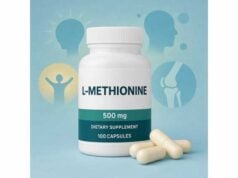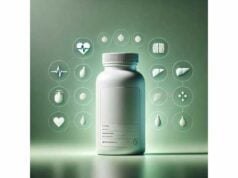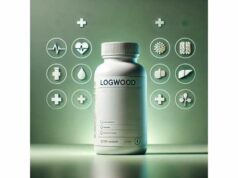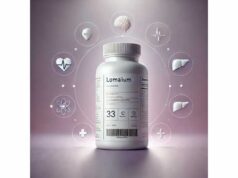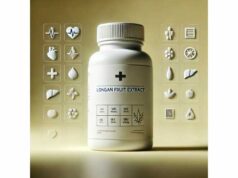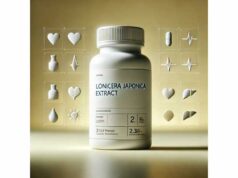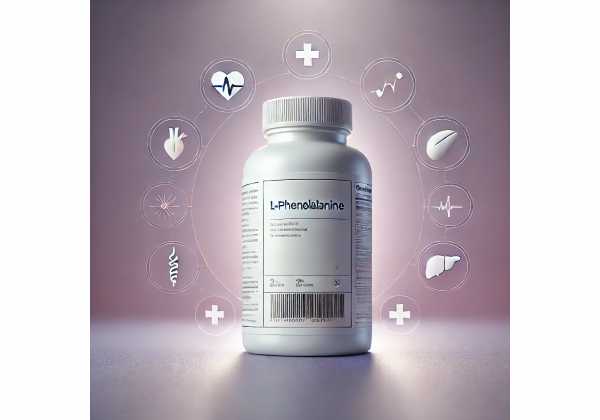
L-phenylalanine (often shortened to L-Phe) is an essential amino acid that your body uses to build proteins and to make tyrosine—the direct precursor to dopamine, norepinephrine, and epinephrine. Because of these roles, L-phenylalanine supplements are marketed for mood, mental energy, and skin repigmentation support (in combination with light therapy for vitiligo). They also appear in nootropic stacks, pre-workout formulas, and some medical nutrition products. Evidence in healthy adults suggests that short-term supplementation within common dosage ranges is generally well tolerated. That said, L-phenylalanine is not risk-free. People with phenylketonuria (PKU) must avoid it, certain drug interactions are plausible, and very high intakes are unnecessary for most goals. This guide translates the science into practical advice: what L-phenylalanine is, how it works, where it might help, how to use it safely, and who should steer clear.
Essential Insights
- May support catecholamine production for focus and motivation; may aid repigmentation when paired with UVA/phototherapy.
- Avoid if you have phenylketonuria (PKU) or are managing pregnancy with PKU; review medications for interactions.
- Typical supplemental range: 250–1,500 mg/day; short trials in healthy adults tolerated up to 12 g/day, but such high doses are unnecessary for most uses.
- Use caution or avoid with MAO inhibitors or levodopa; discuss with your clinician if you have hypertension, anxiety, or sleep issues.
Table of Contents
- What it is and how it works
- Benefits: what the evidence says
- How to take it wisely
- Dosage by goal and timing
- Safety, interactions, who should avoid
- Evidence snapshot and research gaps
What it is and how it works
L-phenylalanine is one of nine indispensable amino acids you must obtain from food or supplements. Inside the body, an enzyme called phenylalanine hydroxylase converts L-phenylalanine into L-tyrosine. Tyrosine then feeds into the catecholamine pathway to form L-DOPA → dopamine → norepinephrine → epinephrine. These neurotransmitters influence attention, motivation, stress response, and cardiovascular tone. Because L-phenylalanine sits at the top of that pathway, increasing intake can raise downstream tyrosine availability under certain conditions, especially when intake is otherwise low.
L-phenylalanine also intersects with pigment biology. In melanocytes, tyrosine is a substrate for melanin synthesis. That’s one reason researchers have explored L-phenylalanine alongside UVA or narrow-band phototherapy to support repigmentation in vitiligo. On its own, L-phenylalanine is not a light therapy; it’s a building block that may make light-induced melanogenesis more efficient in select protocols.
There are three supplement forms to know:
- L-phenylalanine (L-Phe): the natural dietary isomer used to build proteins and make tyrosine and catecholamines.
- D-phenylalanine (D-Phe): the mirror isomer; not used for protein synthesis. It has been studied for pain because it may slow the breakdown of endogenous enkephalins.
- DL-phenylalanine (DLPA): a 50:50 mixture combining the potential catecholaminergic effects of L-Phe with the enkephalinase-related effects of D-Phe.
Food sources include meat, fish, eggs, dairy, legumes, and soy. Phenylalanine is also released when aspartame is digested, which matters for people with PKU who must tightly limit phenylalanine exposure from all sources, including foods, supplements, and certain medications.
Two more concepts matter for users:
- Large Neutral Amino Acid (LNAA) competition. Phenylalanine, tyrosine, tryptophan, leucine, isoleucine, and valine share intestinal and blood–brain barrier transporters. Taking L-phenylalanine with high-protein meals or multiple LNAAs can reduce its relative uptake into the brain.
- Cofactors. Catecholamine synthesis requires tetrahydrobiopterin (BH4), iron, vitamin B6, vitamin C, and copper. If any of these are limited, simply adding L-phenylalanine may have a smaller effect on neurotransmitter output.
Bottom line: L-phenylalanine is a versatile amino acid with plausible mechanisms for cognitive and pigmentation-related effects, but context—overall diet, cofactors, and light exposure—determines results.
Benefits: what the evidence says
1) Skin repigmentation in vitiligo (with light therapy).
Several clinical investigations have paired oral L-phenylalanine with UVA or narrow-band UVB phototherapy. In these protocols, L-phenylalanine is given before each session to raise substrate availability for melanin synthesis. Trials report partial repigmentation in subsets of patients, with best responses on sun-exposed or hair-bearing sites. Repigmentation depends heavily on consistent light therapy, lesion location, and disease activity. Importantly, higher L-phenylalanine doses do not necessarily improve outcomes beyond a threshold; protocol details and adherence matter more than “more milligrams.” For readers considering this approach, the key is to work with a dermatology team who can personalize the schedule, dose, and light parameters.
2) Mood, drive, and cognitive performance: modest, context-dependent.
Because phenylalanine leads to tyrosine and dopamine, L-phenylalanine is included in nootropics for motivation or mental energy, especially under stress or sleep loss when catecholamine demand is elevated. Real-world reports range from subtle alertness to no discernible effect. In controlled settings, benefits are more robust for tyrosine than phenylalanine during acute stress tasks, likely because tyrosine bypasses the phenylalanine hydroxylase step. Still, if your habitual protein intake is marginal or your diet is low in tyrosine, L-phenylalanine may indirectly support catecholamine synthesis.
3) Pain support with DL-phenylalanine (DLPA).
DLPA combines L- and D- isomers. D-phenylalanine has been explored for analgesia through inhibition of enkephalin-degrading enzymes, potentially enhancing the body’s own pain-modulating peptides. Findings include potentiation of opioid analgesia and small studies suggesting reduced pain intensity in some chronic pain conditions. Effects are variable, and D- or DL-phenylalanine should not be combined with pain medications without medical guidance.
4) Blood pressure biology (preclinical).
Animal studies suggest L-phenylalanine may improve nitric oxide bioavailability and vascular function under high-salt conditions by influencing BH4-related pathways. This is intriguing mechanistically but not a reason to self-treat hypertension with phenylalanine. Human blood pressure is regulated by many factors; anyone with hypertension should prioritize proven therapies and discuss supplements with their clinician.
5) General nutrition and protein adequacy.
If you eat enough high-quality protein (roughly 0.8–1.2 g/kg/day for most adults, higher for athletes or during calorie deficits), you will almost certainly meet phenylalanine needs through food. Supplements are best reserved for specific, clinician-guided protocols (e.g., peri-phototherapy in vitiligo) or targeted nootropic stacks when diet is otherwise optimized.
Takeaway: The most consistent role for L-phenylalanine is as an adjunct to light therapy in vitiligo. Cognitive or mood effects are plausible but inconsistent and often smaller than with tyrosine. DLPA may help select pain cases but requires professional oversight.
How to take it wisely
Choose the right form for your goal.
- For focus/motivation: L-phenylalanine or L-tyrosine. Tyrosine usually has stronger acute evidence for cognitive tasks; L-phenylalanine can still be useful if you prefer a broader amino-acid base approach or stack it with tyrosine at lower doses.
- For pain protocols: DL-phenylalanine (DLPA), under clinician supervision.
- For vitiligo protocols: L-phenylalanine taken before clinician-directed light therapy (UVA/NB-UVB). Do not DIY light exposure.
Timing and co-ingestion.
- Empty stomach or light, low-protein snack 30–60 minutes before desired effect can reduce competition from other LNAAs for transport.
- Hydration helps capsule dissolution and tolerance.
- Cofactors: ensure adequate iron, vitamin B6, vitamin C, and overall protein. If you eat a balanced diet, dedicated cofactor pills are usually unnecessary.
Stacking examples (illustrative, not medical advice):
- Alertness stack (occasional use): L-phenylalanine 300–500 mg + caffeine 50–100 mg. If sensitive to stimulants, skip caffeine.
- Focus under stress: Swap L-phenylalanine for L-tyrosine (e.g., 500–1,000 mg), or use a smaller L-phenylalanine dose (250–500 mg) plus tyrosine (250–500 mg).
- Phototherapy day (dermatology-guided): L-phenylalanine timed per clinic instructions (often 30–60 minutes prior to the session). Do not exceed the plan laid out by your clinician.
Quality checks.
- Look for products that disclose the isomer (L-, D-, or DL-), use reputable manufacturers, batch numbers, and third-party testing (USP, NSF, Informed Choice).
- Avoid blends that hide amounts in proprietary matrices. You should know how many milligrams you’re taking.
When to reassess or stop.
- If you notice anxiety, insomnia, palpitations, new headaches, or blood pressure spikes, reduce the dose or stop and discuss with your clinician.
- If taking for cognitive support and you feel no benefit after 1–2 weeks at a conservative dose, continuing is unlikely to help.
- If starting new medications (especially MAO inhibitors or levodopa/carbidopa), review all supplements for interactions.
Dosage by goal and timing
Everyday supplemental use (general cognitive or mood support).
- Common range: 250–750 mg/day, taken once in the morning or split twice daily.
- Upper practical limit for most people: 1,500 mg/day.
- Short-term tolerance in healthy adults: Human safety trials have reported no observed adverse effects at 12 g/day over several weeks in controlled settings. Those trials inform upper-limit research, not everyday practice; most users should remain in the 250–750 mg/day range.
Before demanding tasks (as-needed).
- 300–500 mg taken 30–60 minutes pre-task on a relatively empty stomach. Consider starting at the low end.
Vitiligo adjunct (with light therapy; dermatology-directed).
- Protocols vary. Oral L-phenylalanine is typically timed before UVA or NB-UVB sessions. Dosing in studies has ranged from below 50 mg/kg/day up to weight-based regimens; higher doses did not consistently improve outcomes. Your dermatologist will tailor the dose, timing, and frequency to your skin type, lesion sites, and light modality.
DL-phenylalanine for pain (clinician-supervised).
- Often 750–2,000 mg/day in divided doses. Responses vary; protocols should be individualized, especially when combined with analgesics.
Special populations.
- PKU: Absolutely avoid supplemental phenylalanine; total intake must be individualized and tightly restricted.
- Pregnancy with PKU: Requires specialized metabolic management of phenylalanine levels; do not supplement.
- Children: Do not use L-phenylalanine supplements for cognitive or mood purposes without pediatric guidance. Dietary protein usually suffices.
How long to give it.
- For cognitive uses, trial 7–14 days at a conservative dose, then reassess.
- For vitiligo, course length follows the light-therapy plan; repigmentation is gradual and site-dependent.
Do not combine with high-protein meals if your goal is central catecholamine support; competition from other amino acids can blunt the effect. Space phenylalanine away from iron supplements by at least 2 hours if you experience nausea.
Safety, interactions, who should avoid
Generally tolerated at typical doses (e.g., 250–1,500 mg/day), with occasional reports of nausea, heartburn, headache, restlessness, or insomnia. Start low if you’re sensitive to stimulants or prone to anxiety.
Absolute or strong cautions.
- Phenylketonuria (PKU) or hyperphenylalaninemia: Avoid. Even routine foods must be managed; supplements can dangerously raise phenylalanine.
- Pregnant individuals with PKU (or planning pregnancy with PKU): Strict metabolic control of phenylalanine is essential to reduce fetal risk; no supplemental use.
- MAO inhibitors (e.g., phenelzine, tranylcypromine, selegiline/rasagiline at higher systemic doses): Combining catecholamine-precursor strategies with MAOIs may raise blood pressure risk; avoid unless your prescriber explicitly approves and monitors.
- Levodopa/carbidopa: Large neutral amino acids—including phenylalanine—can compete with levodopa for transport and absorption. Timing protein and L-NAA intake away from levodopa is standard; adding phenylalanine supplements may further reduce medication effectiveness. Coordinate with your neurologist.
- Uncontrolled hypertension, arrhythmias, panic disorder, severe insomnia: Use with caution or avoid; catecholamine-related effects may aggravate symptoms.
Other considerations.
- Drug classes to review: stimulants, thyroid hormone, antipsychotics, sedatives, and any drug affecting blood pressure or heart rhythm.
- Aspartame intake: If you’re tracking overall phenylalanine exposure, remember that diet drinks and sugar-free products containing aspartame add to your total.
- Liver or kidney disease: Discuss any amino-acid supplement with your care team.
Lab tests and monitoring (when appropriate).
- For routine healthy users at modest doses, no tests are required.
- In clinical settings (e.g., PKU management or phototherapy research), clinicians may monitor plasma amino acids, tyrosine, or related markers.
If you experience severe headache, chest pain, marked anxiety or agitation, palpitations, or a sustained spike in blood pressure, stop the supplement and seek medical attention.
Evidence snapshot and research gaps
- Safety: Human tolerance studies in healthy adults support short-term safety at graded intakes up to 12 g/day, with the highest dose setting a practical “no-observed-adverse-effect level” in those trials. That is far above common real-world intakes and should not be a target dose.
- Vitiligo: Clinical studies combining oral L-phenylalanine with UVA or narrow-band UVB report partial repigmentation in some patients, particularly in sun-exposed or hair-bearing areas. Responses vary widely, and protocols must be individualized.
- Cognition/mood: Biological plausibility is strong (catecholamine pathway), but human outcome data for L-phenylalanine are mixed and often indirect. Tyrosine shows more consistent benefits in acute stress; whether L-phenylalanine meaningfully outperforms diet-first strategies remains uncertain.
- Pain (DLPA): Small or older trials suggest analgesic potential via enkephalinase inhibition and opioid-sparing effects. Larger, contemporary randomized trials are needed.
- Cardiometabolic biology: Preclinical data indicate vascular and nitric-oxide benefits under high-salt stress; human trials are lacking.
What would move the field forward?
- Randomized, adequately powered trials comparing L-phenylalanine vs. L-tyrosine on cognitive and mood endpoints under stress.
- Standardized vitiligo protocols specifying dose, timing, light type, and lesion characteristics, with long-term follow-up.
- Modern DLPA pain trials that include mechanism-focused biomarkers and opioid-sparing outcomes.
- Population studies clarifying whether habitual phenylalanine intake relates to blood pressure or anxiety in specific subgroups.
Until then, L-phenylalanine is best viewed as a targeted adjunct—useful in well-defined contexts and doses, and unnecessary at gram-level intakes for most people.
References
- Subchronic Tolerance Trials of Graded Oral Supplementation with Phenylalanine or Serine in Healthy Adults 2021 (Clinical Trial)
- Tolerable Upper Intake Level for Individual Amino Acids in Humans: A Narrative Review of Recent Clinical Studies 2023 (Systematic Review)
- L-phenylalanine and UVA irradiation in the treatment of vitiligo 1994 (Clinical Trial)
- L-phenylalanine attenuates high salt-induced hypertension in Dahl SS rats through activation of GCH1-BH4 2021
- Aspartame and Other Sweeteners in Food 2025 (Guidance)
Medical Disclaimer
This article is for educational purposes only and is not a substitute for professional medical advice, diagnosis, or treatment. Do not start, stop, or change any supplement or medication based on this content. If you have health concerns, take prescription drugs (especially MAO inhibitors or levodopa), are pregnant, breastfeeding, or have phenylketonuria (PKU), consult a qualified healthcare professional before using L-phenylalanine or related products.
If you found this guide useful, please consider sharing it on Facebook, X (formerly Twitter), or your preferred platform, and follow us for future evidence-based updates. Your support helps us continue creating high-quality, reader-first content.

